Tessa’s Recipe Rundown
Taste: My homemade dinner rolls are super buttery with the perfect balance of sweetness and saltiness.
Texture: These are fluffy, soft dinner rolls with a golden brown exterior.
Ease: If it’s your first time trying out homemade bread recipes, these dinner rolls are a great place to start!
Why You’ll Love This Recipe: This recipe is easy, relatively quick to make, and yields delicious dinner rolls perfect for Thanksgiving or any special occasion.
This post may contain affiliate links. Read our disclosure policy.
Soft, golden, and buttery — these homemade dinner rolls turn any meal into something special, especially around the holidays. I love them at Thanksgiving, but whether I serve them with a holiday turkey or a weeknight roast, they disappear quick.
If you’ve ever felt nervous about baking with yeast, I promise this recipe will change that. With my step-by-step tips, make-ahead instructions, and an easy shaping video, you’ll have pillowy, bakery-style rolls that’ll impress your family (and yourself)!

Reader Love
These were delicious! I tested these side-by-side with two other highly rated dinner roll recipes. In my opinions, these had the best, buttery, yeasty flavor. Although they rose very tall and were very flaky and fluffy, they are chewy and satisfying. Even more, they look beautiful and shiny.
–
Ingredients Needed
Every ingredient in this recipe plays a key role in creating soft, fluffy, and buttery homemade dinner rolls. Here’s why each one matters:
- Water: Lukewarm water activates the yeast, which is essential for helping the dough rise. If it’s too hot, it kills the yeast and prevents the dough from rising. Too cold, and the dough will take forever to rise. I make sure it’s around 100-110°F.
- Milk: Whole milk adds richness and tenderness. The fat in the milk helps soften the rolls while giving them a slightly sweet flavor that balances the butter and sugar. The milk should also be warmed to 100-110°F so the yeast is properly activated.
- Butter: Melted butter adds flavor, moisture, and a tender crumb. I also use a little for greasing the bowl and pan to prevent sticking and enhance browning.
- Eggs: Eggs enrich the dough and contribute to structure and flavor. I lightly beat them before adding to ensure they mix evenly. I also use an egg wash before baking to give the rolls a shiny, golden-brown finish.
- Granulated Sugar: Don’t skip this one! There’s just a touch in these dinner rolls to help make them tender and golden brown. I wrote a whole guide to sugar’s role in baking, as it does SO much more than simply sweetening!
- Salt: Fine sea salt enhances flavor and balances the sweetness. I sometimes sprinkle flaky sea salt on top for an extra layer of flavor.
- Instant Yeast: I use instant yeast to simplify the process and skip proofing. It ensures a consistent rise and fluffy texture, but you can also use active dry yeast. Add it to the dry ingredients, like you would with instant yeast. Just know the dough will take about 20% more time to rise.
- Bread Flour: Bread flour has more protein than all-purpose, which gives the rolls structure while keeping them soft and chewy. You can swap with the same amount of all-purpose flour, but the rolls may take longer to knead and rise, and be less chewy.
Recommended Equipment
I use a stand mixer with a dough hook for these Thanksgiving rolls because it makes kneading the enriched, slightly sticky dough much easier and faster.
That said, you can absolutely knead it by hand. Make sure to knead until the dough is smooth and elastic so the rolls hold their shape and bake up soft and fluffy. If you’re not using a stand mixer, see my full tutorial on how to knead dough.
For baking, I generally use a 9×13-inch pan. I usually prefer metal because it conducts heat efficiently and helps the rolls bake evenly. I also love ceramic or glass for holiday presentations. Either works beautifully, but keep an eye on the bake time
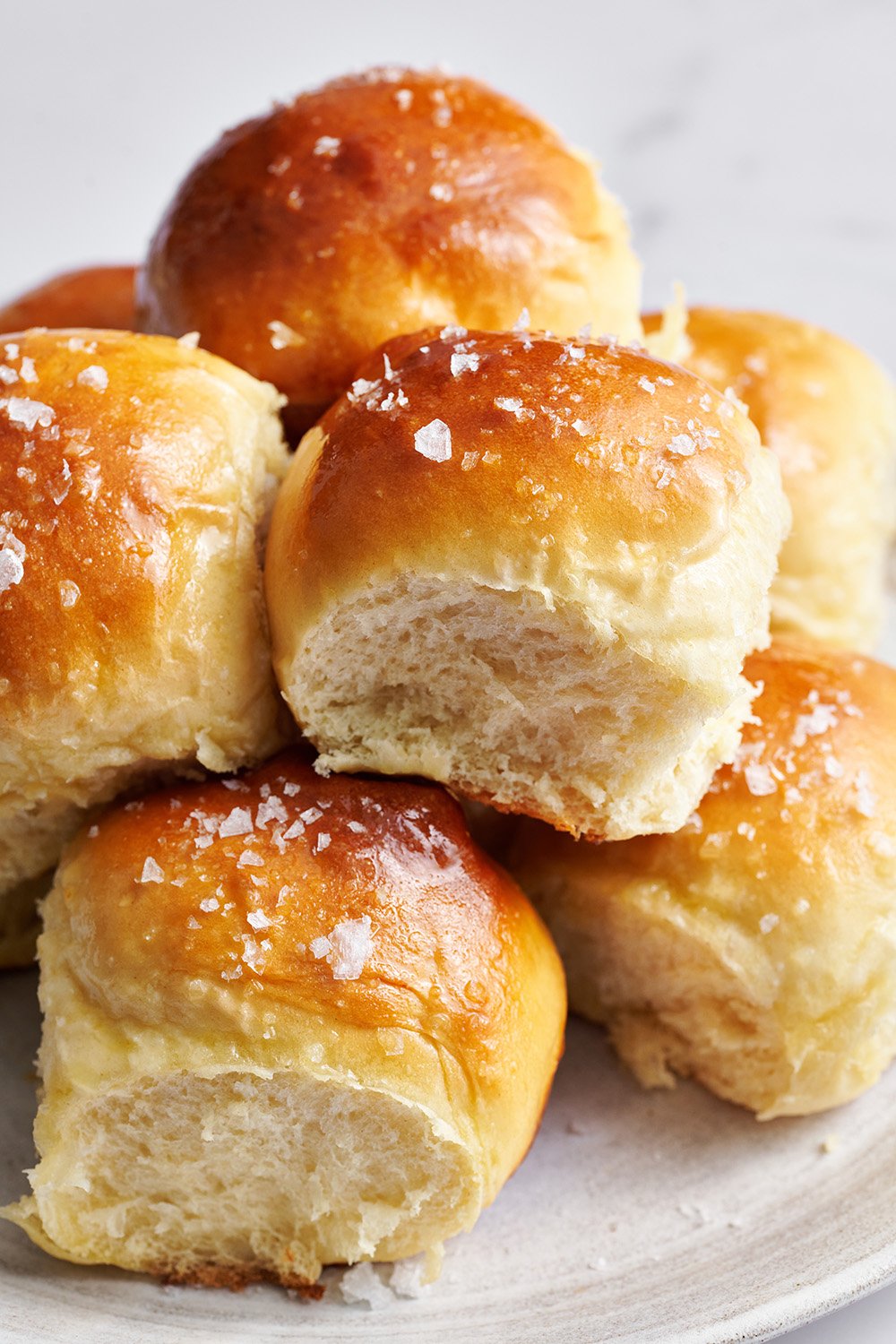

Sprinkle of Science
How to Make the Ultimate Dinner Rolls

I tested and tweaked this recipe until every batch came out perfectly soft, fluffy, and golden. The steps are approachable, even for beginners. My bonus tips will help your rolls turn out beautifully every time.
1. Mix the Dough
Start by combining warm water and milk (100–110°F), melted butter, eggs, sugar, salt, and yeast in a stand mixer bowl. Add 2 cups of flour first to form a rough dough, then gradually knead in the remaining flour using the dough hook.
Expert tip: When you measure out your flour, I highly recommend using a digital kitchen scale for accuracy. If you don’t have one, use the spoon and level method to ensure you’re not accidentally compacting too much flour in your measuring cups.
The dough should feel soft, slightly tacky, and elastic. If it’s sticky, dampen your hands with water rather than adding extra flour, which could make the rolls too dense. I use a stand mixer to save my arms, but you can also knead by hand until the dough is smooth and elastic.
2. First Rise
Lightly grease a large mixing bowl and place the dough inside, turning it to coat the top with oil so it doesn’t dry out. Cover the greased bowl loosely and let it rise in a warm, draft-free spot until it roughly doubles in size. That process usually takes about 60-90 minutes.
I check readiness with the “ripe” finger test: if my fingers leave a lasting indentation, the dough is ready. If not, I give it a little more time.
3. Shape the Rolls
Once the dough has risen, gently deflate it and transfer it to a clean, unfloured surface. Divide the dough into 12 equal pieces using a bench scraper or knife. Then pinch and roll each piece into a tight ball to create the rolls.
Don’t flour your work surface when shaping the rolls; you want some resistance to form them into taut balls. My video on shaping dinner rolls is a great visual guide to see my technique in action.
You can also get creative with shaping your dough! Check out my guide for 5 ways to shape bread rolls.
4. Second Rise
Place the shaped rolls in a greased 9×13-inch pan and lightly cover them. Let them rise again until they double in size. If I plan to bake later, I’ll refrigerate the shaped rolls for up to 24 hours. The slower rise actually helps the flavor develop. Let the rolls come to room temperature before baking.
You can use the same finger test here. Here’s what my dough looked like before and after rising:

5. Bake and Finish
Brush the rolls with a lightly beaten egg for a glossy golden finish, then bake at 375°F for about 20 minutes until golden brown. Once out of the oven, brush with melted butter and sprinkle with flaky sea salt.
Flavor Twists and Variations
I put in quite a few hours of testing to come up with the best dinner rolls, but once you’ve got the basics down, you can play with flavors. Try these variations:
- Brush the tops with melted butter mixed with minced garlic and chopped fresh herbs like rosemary, thyme, or parsley for a garlic butter version.
- Sprinkle shredded cheese over the tops right before baking for a savory twist.
- You can also add a touch more sugar and a pinch of cinnamon to the dough for breakfast-style rolls that aren’t as sweet as cinnamon rolls.
And if you’re craving more, check out a few of my favorite roll recipes:
- Garlic, Herb, and Cheese Rolls
- Garlic Knot Rolls
- Homemade Hawaiian Bread Rolls
- Soft Butter Rolls
- Sweet Potato Dinner Rolls
Serving Suggestions
These soft, buttery rolls are the kind of side that works with just about anything. I love serving them as an easy Thanksgiving dish or alongside Christmas ham. They’re just as good with cozy soups, stews, or a simple roast chicken.
They also make great leftovers when re-heated or toasted. Slice them in half for sliders, breakfast sandwiches, or even mini pulled pork buns. For an easy appetizer, you can serve them with flavored butters, like honey butter or garlic herb butter, to make them feel extra special.
Make-Ahead, Storing, and Freezing Tips
You can make most yeast mixtures ahead of time, and this recipe is no exception. I like to mix the dough, let it rise once, and shape the rolls. Then I cover the pan tightly with plastic wrap and refrigerate for up to 24 hours. Chilling slows the rise and allows more flavor to develop overnight.
When it’s time to bake, I bring the rolls to room temperature as the oven preheats. If they haven’t quite doubled in size yet, I just give them a little more time before baking.
The rolls are best freshly baked, but leftovers reheat beautifully. Warm them in a 300°F oven or toaster oven until just heated through. Store in an airtight container or zip-top bag for up to 3 days.
To freeze unbaked rolls, shape the dough after the first rise and place them in a baking dish. Cover tightly with plastic wrap and freeze flat for up to 2 months. When you’re ready to bake, thaw them to room temperature, let them rise until an indentation stays when pressed, and bake as directed.
You can also freeze baked dinner rolls. Once cooled, store them in an airtight container for up to a month. Thaw to room temperature before reheating and serving.

More Side Dishes You’ll Love:
- Apple and Sausage Stuffing
- Cheesy Green Bean Casserole
- Crispy Parmesan-Rosemary Roasted Potatoes
- Crowd-Pleasing Sweet Potato Casserole
- Homemade Cranberry Sauce
FAQs
How are dinner rolls different from bread?
Dinner rolls are small, soft, and often slightly sweetened breads meant to accompany a meal. They come baked in individual portions, so they’re perfect for sharing at the table. Think of them as mini loaves designed to elevate your meal, especially at Thanksgiving.
Why aren’t my yeast rolls fluffy?
If your yeast rolls aren’t coming out fluffy, it’s usually because the dough didn’t get enough time to rise, was over-floured, or wasn’t kneaded enough. I always make sure my dough doubles in size and resist the urge to add extra flour to sticky dough. It’s also important for the liquids to be around 100-110°F so the yeast can do its job.
How do you keep dinner rolls soft and fresh?
To keep dinner rolls soft and fresh, store any leftovers in an airtight container or zip-top bag at room temperature for up to 3 days. Reheat them for a few minutes in a 300°F oven or toaster oven until they’re warmed through to refresh before serving.

Ultimate Dinner Rolls
Email This Recipe
Enter your email, and we’ll send it to your inbox.
Ingredients
- ¼ cup (59 grams) lukewarm water (100 to 110°F)
- 1 cup (237 grams) warm milk (100 to 110°F)
- 1 tablespoon (14 grams) unsalted butter, melted, plus more for greasing
- 2 large eggs, lightly beaten
- 2 tablespoons (25 grams) granulated sugar
- 1 ½ teaspoons fine sea salt
- 2 ¼ teaspoons (1 packet) instant yeast
- 4 ½ cups (572 grams) bread flour
For egg wash & finishing
- 1 egg, lightly beaten
- Melted butter
- Flaky sea salt, for sprinkling
Instructions
- Combine the water, milk, 1 tablespoon of the melted butter, eggs, sugar, salt, and yeast in the bowl of a stand mixer.
- Add 2 cups (254 grams) of the flour and stir with a wooden spoon until the dough forms a rough, shaggy mass.
- Attach the dough hook to the mixer, turn to medium-low speed, and gradually add the remaining flour, kneading until a mass of dough begins to form.
- Continue kneading on medium-high speed for 4 to 5 minutes until a soft, smooth ball of dough is formed. The dough ball should feel elastic and slightly tacky to the touch.
- Lightly spray a large bowl with cooking spray and place the dough in the bowl. Cover the bowl lightly with plastic wrap or a kitchen towel.
- Let dough rise for about 1 hour to 90 minutes at room temperature or until the dough is big, puffy, and about doubled in size.
- Grease a 9×13-inch or similarly shaped baking pan with butter. Gently deflate the dough.
- Use a bench scraper, knife, or pizza wheel to divide the dough into 12 equal pieces. Shape each piece into a ball and place it in the prepared pan.
- Lightly cover the dough with plastic wrap and let the rolls rise for about 1 hour, or until about doubled in size.
- Preheat the oven to 375°F.
- Brush the rolls gently with the beaten egg. Bake for 20 minutes or until golden brown.
- Brush with melted butter and sprinkle with flaky salt. Serve warm. Store leftovers in an airtight container or zip-top bag for up to 3 days.
Recipe Notes
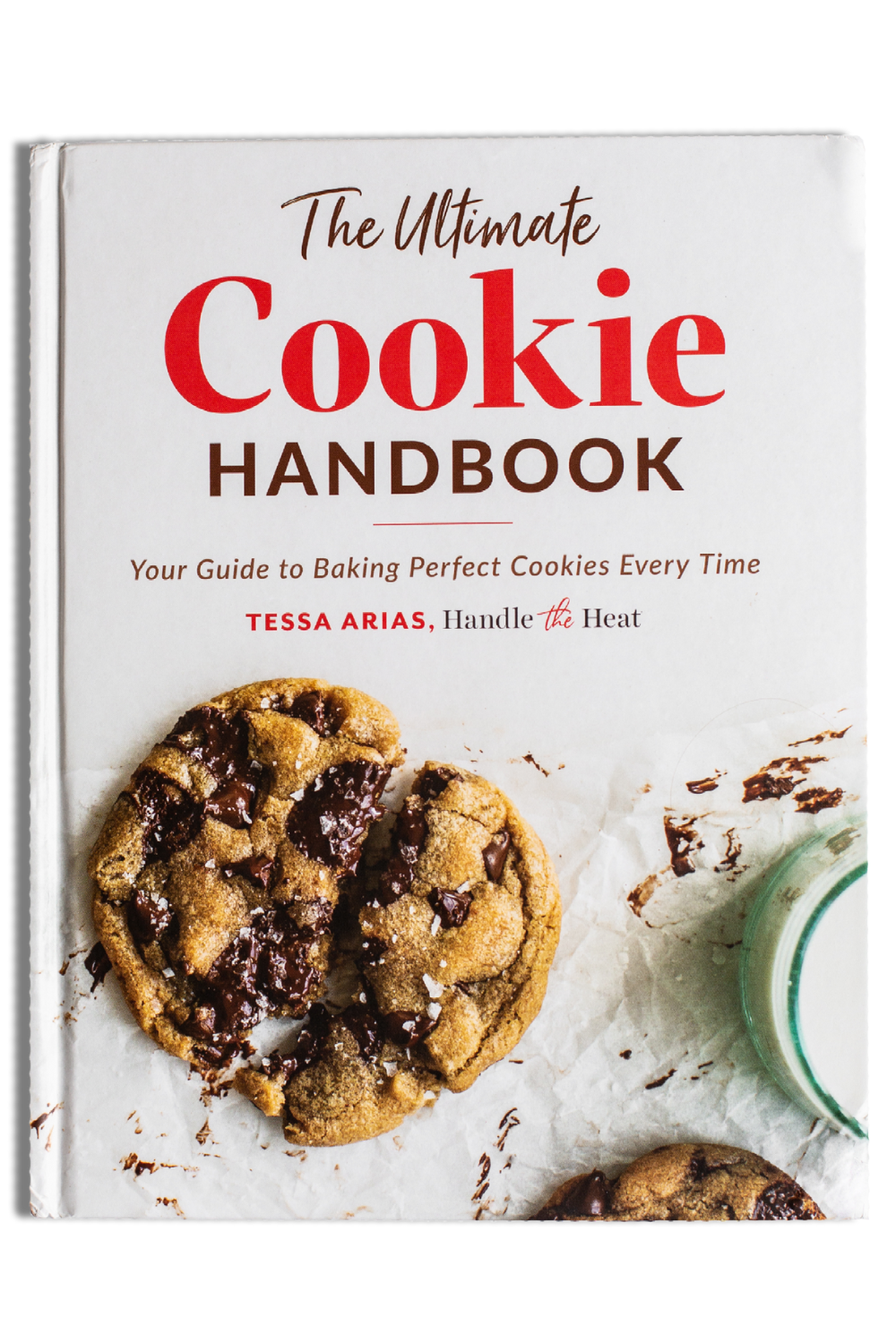
The Ultimate Cookie Handbook
Learn the sweet SCIENCE of cookie baking in a fun, visual way to customize your own recipes frustration-free. Plus, my best 50+ homemade cookies!
This recipe was originally published in 2013 and has been updated with new photos and more baking tips. Photos by Joanie Simon.
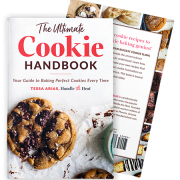
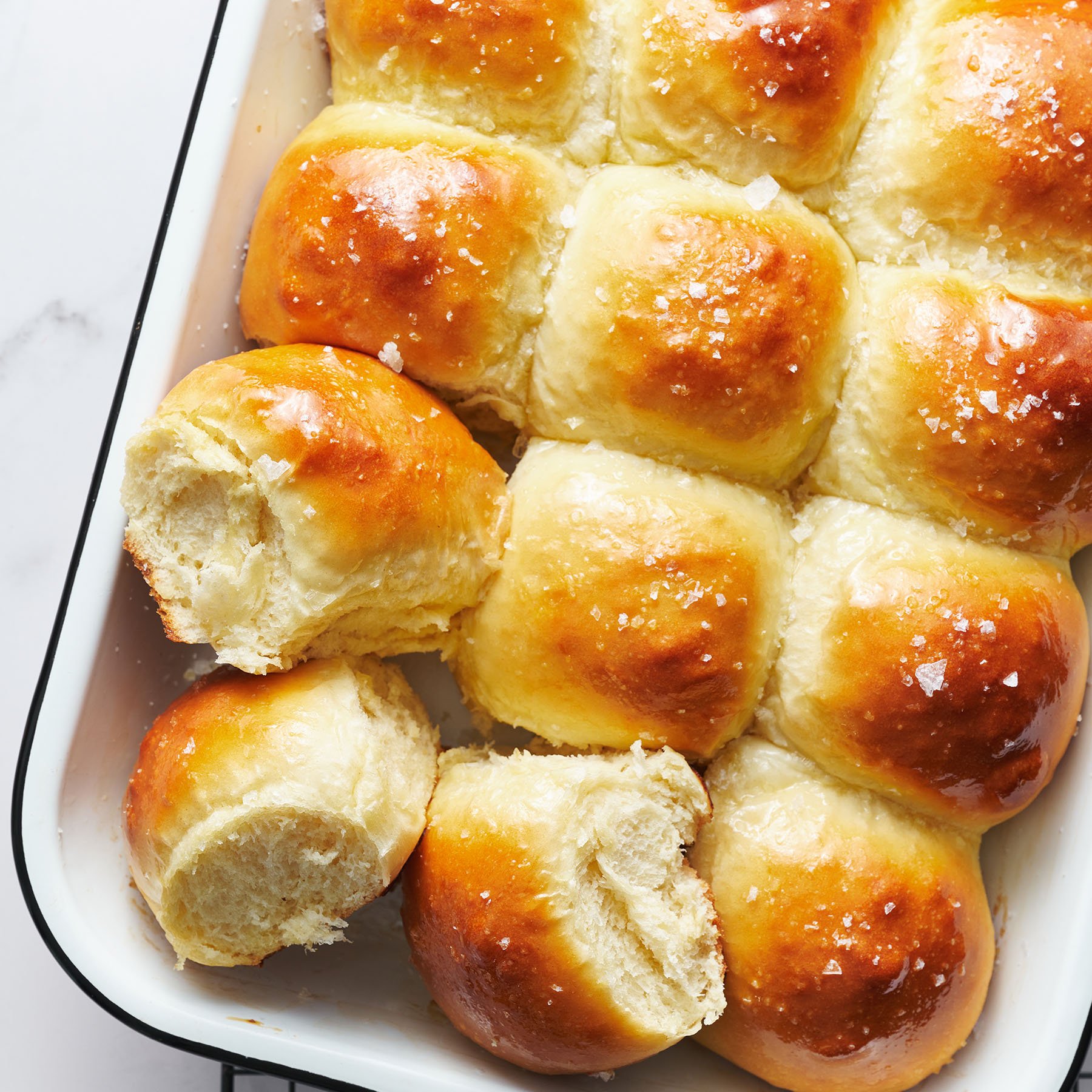





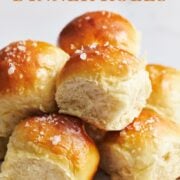
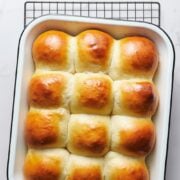
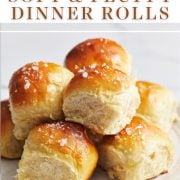
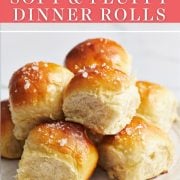
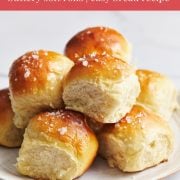
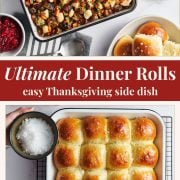
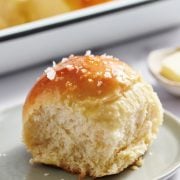
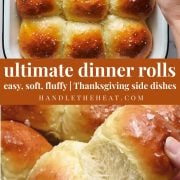
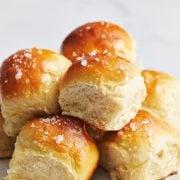
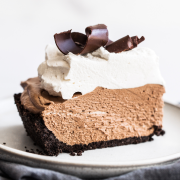


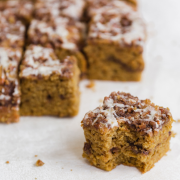



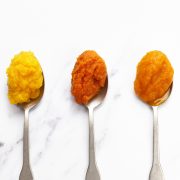

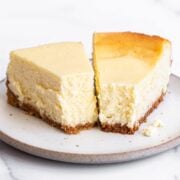
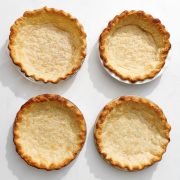








Can we make these without the help of a stand mixer? And what would be the procedure.
Easy and delicious! If you’re a new yeast baker, the video shows you exactly how your dough should look.
Easy to do. Very delicious. Very soft. Thanks for this recipe!
Great recipe used to make dinner rolls. Those were a hit with the family over half eaten before dinner was ready. Not a big deal because it made so many. Today I’m making the dough to use for cinnamon rolls
If I want to halve the recipe – do I take half of all the ingredients? What will be the amount of yeast to be used?
Hi! I’m excited to make these, but I am wondering if I can sub Oat Milk for the milk in this recipe?
Hi
Can i double the recipe?
Made these for dinner tonight…they turned out perfect! Will be making again! Thanks for the recipe!
I’ve baked bread for 50 years and now this is one of my favorite recipes. I knead the dough though by hand and it came out lighter. Great upper body exercise!
Followed recipe to a tee and they turned out perfect!
Great easy delicious recipe!
These are the BEST! Seriously!